Chapter 2
2.3 Since m is not a prime, it can be factored as the product of two integers a and b,
m = a · b
with 1 < a, b < m. It is clear that both a and b are in the set {1, 2,··· , m − 1}. It follows
from the definition of modulo-m multiplication that
a b = 0.
Since 0 is not an element in the set {1, 2,··· , m−1}, the set is not closed under the modulo-m
multiplication and hence can not be a group.
2.5 It follows from Problem 2.3 that, if m is not a prime, the set {1, 2,··· , m − 1} can not be a
group under the modulo-m multiplication. Consequently, the set {0, 1, 2,··· , m − 1} can not
be a field under the modulo-m addition and multiplication.
2.7 First we note that the set of sums of unit element contains the zero element 0. For any 1 ≤
1 +
1 =
1 = 0.
i=1
i=1
i=1
Hence every sum has an inverse with respect to the addition operation of the field GF(q). Since
the sums are elements in GF(q), they must satisfy the associative and commutative laws with
respect to the addition operation of GF(q). Therefore, the sums form a commutative group
under the addition of GF(q).
Next we note that the sums contain the unit element 1 of GF(q). For each nonzero sum
1
with 1 ≤ < λ, we want to show it has a multiplicative inverse with respect to the multipli-
cation operation of GF(q). Since λ is prime, and λ are relatively prime and there exist two
i=1
1
< λ,
λ−
λ
�
integers a and b such that
a · + b · λ = 1,
where a and λ are also relatively prime. Dividing a by λ, we obtain
a = kλ + r with 0 ≤ r < λ.
Since a and λ are relatively prime, r = 0. Hence
Combining (1) and (2), we have
1 ≤ r < λ
· r = −(b + k) · λ + 1
(1)
(2)
Consider
r
1 ·
i=1
i=1
1 =
·r
λ
i=1
−(b+k)·λ
−(b+k)
i=1
1 =
+1
= (
1)(
1) + 1
i=1
i=1
= 0 + 1 = 1.
Hence, every nonzero sum has an inverse with respect to the multiplication operation of GF(q).
Since the nonzero sums are elements of GF(q), they obey the associative and commutative
laws with respect to the multiplication of GF(q). Also the sums satisfy the distributive law.
As a result, the sums form a field, a subfield of GF(q).
2.8 Consider the finite field GF(q). Let n be the maximum order of the nonzero elements of GF(q)
and let α be an element of order n. It follows from Theorem 2.9 that n divides q − 1, i.e.
q − 1 = k · n.
Thus n ≤ q − 1. Let β be any other nonzero element in GF(q) and let e be the order of β.
2
�
Suppose that e does not divide n. Let (n, e) be the greatest common factor of n and e. Then
e/(n, e) and n are relatively prime. Consider the element
β(n,e)
This element has order e/(n, e). The element
αβ(n,e)
has order ne/(n, e) which is greater than n. This contradicts the fact that n is the maximum
order of nonzero elements in GF(q). Hence e must divide n. Therefore, the order of each
nonzero element of GF(q) is a factor of n. This implies that each nonzero element of GF(q)
is a root of the polynomial
X n − 1.
Consequently, q − 1 ≤ n. Since n ≤ q − 1 (by Theorem 2.9), we must have
n = q − 1.
Thus the maximum order of nonzero elements in GF(q) is q-1. The elements of order q − 1
are then primitive elements.
2.11 (a) Suppose that f (X) is irreducible but its reciprocal f∗(X) is not. Then
f∗(X) = a(X) · b(X)
where the degrees of a(X) and b(X) are nonzero. Let k and m be the degrees of a(X) and
b(X) respectivly. Clearly, k + m = n. Since the reciprocal of f∗(X) is f (X),
f (X) = X nf∗(
1
X
) = X ka(
1
X
) · X mb(
1
X
).
This says that f (X) is not irreducible and is a contradiction to the hypothesis. Hence f∗(X)
must be irreducible. Similarly, we can prove that if f∗(X) is irreducible, f (X) is also
irreducible. Consequently, f∗(X) is irreducible if and only if f (X) is irreducible.
3
�
(b) Suppose that f (X) is primitive but f∗(X) is not. Then there exists a positive integer k less
than 2n − 1 such that f∗(X) divides X k + 1. Let
X k + 1 = f∗(X)q(X).
Taking the reciprocals of both sides of the above equality, we have
1
X
X k + 1 = X kf∗(
= X nf∗(
= f (X) · X k−nq(
1
X
1
X
1
X
).
)
)q(
) · X k−nq(
1
X
)
This implies that f (X) divides X k + 1 with k < 2n − 1. This is a contradiction to the
hypothesis that f (X) is primitive. Hencef∗(X) must be also primitive. Similarly, if f∗(X) is
primitive, f (X) must also be primitive. Consequently f∗(X) is primitive if and only if f (X)
is primitive.
2.15 We only need to show that β, β2,··· , β2e−1 are distinct. Suppose that
for 0 ≤ i, j < e and i < j. Then,
β2i = β2j
(β2j−i−1)2i = 1.
Since the order β is a factor of 2m − 1, it must be odd. For (β2j−i−1)2i = 1, we must have
β2j−i−1 = 1.
Since both i and j are less than e, j − i < e. This is contradiction to the fact that the e is the
smallest nonnegative integer such that
β2e−1 = 1.
4
�
Hence β2i = β2j for 0 ≤ i, j < e.
2.16 Let n be the order of β2i. Then
Hence
(β2i)n
= 1
(βn
)2i = 1.
(1)
Since the order n of β is odd, n and 2i are relatively prime. From(1), we see that n divides n
and
Now consider
n = kn.
(β2i)n = (βn)2i = 1
This implies that n (the order of β2i) divides n. Hence
From (2) and (3), we conclude that
n = n
n = n.
(2)
(3)
2.20 Note that c· v = c· (0 + v) = c· 0 + c· v. Adding −(c· v) to both sides of the above equality,
we have
c · v + [−(c · v)] = c · 0 + c · v + [−(c · v)]
0 = c · 0 + 0.
Since 0 is the additive identity of the vector space, we then have
c · 0 = 0.
2.21 Note that 0 · v = 0. Then for any c in F ,
(−c + c) · v = 0
5
�
(−c) · v + c · v = 0.
Hence (−c) · v is the additive inverse of c · v, i.e.
Since c · 0 = 0 (problem 2.20),
−(c · v) = (−c) · v
c · (−v + v) = 0
c · (−v) + c · v = 0.
Hence c · (−v) is the additive inverse of c · v, i.e.
−(c · v) = c · (−v)
From (1) and (2), we obtain
−(c · v) = (−c) · v = c · (−v)
(1)
(2)
2.22 By Theorem 2.22, S is a subspace if (i) for any u and v in S, u + v is in S and (ii) for any c
in F and u in S, c · u is in S. The first condition is now given, we only have to show that the
second condition is implied by the first condition for F = GF (2). Let u be any element in S.
It follows from the given condition that
u + u = 0
is also in S. Let c be an element in GF(2). Then, for any u in S,
0 f or
u f or
c · u =
c = 0
c = 1
Clearly c · u is also in S. Hence S is a subspace.
2.24 If the elements of GF(2m) are represented by m-tuples over GF(2), the proof that GF(2m) is
6
�
a vector space over GF(2) is then straight-forward.
2.27 Let u and v be any two elements in S1 ∩ S2. It is clear the u and v are elements in S1, and u
and v are elements in S2. Since S1 and S2 are subspaces,
and
u + v ∈ S1
u + v ∈ S2.
Hence,u + v is in S1 ∩ S2. Now let x be any vector in S1 ∩ S2. Then x ∈ S1, and x ∈ S2.
Again, since S1 and S2 are subspaces, for any c in the field F , c · x is in S1 and also in S2.
Hence c · v is in the intersection, S1 ∩ S2. It follows from Theorem 2.22 that S1 ∩ S2 is a
subspace.
7
�
Chapter 3
3.1 The generator and parity-check matrices are:
0 1 1 1 1 0 0 0
1 1 1 0 0 1 0 0
1 1 0 1 0 0 1 0
G =
H =
1 0 0 0 0 1 1 1
0 1 0 0 1 1 1 0
0 0 1 0 1 1 0 1
1 0 1 1 0 0 0 1
0 0 0 1 1 0 1 1
From the parity-check matrix we see that each column contains odd number of ones, and no
two columns are alike. Thus no two columns sum to zero and any three columns sum to a 4-
tuple with odd number of ones. However, the first, the second, the third and the sixth columns
sum to zero. Therefore, the minimum distance of the code is 4.
3.4 (a) The matrix H1 is an (n− k +1)× (n + 1) matrix. First we note that the n− k rows of H are
linearly independent. It is clear that the first (n− k) rows of H1 are also linearly independent.
The last row of H1 has a 1 at its first position but other rows of H1 have a 0 at their first
position. Any linear combination including the last row of H1 will never yield a zero vector.
Thus all the rows of H1 are linearly independent. Hence the row space of H1 has dimension
n − k + 1. The dimension of its null space, C1, is then equal to
dim(C1) = (n + 1) − (n − k + 1) = k
Hence C1 is an (n + 1, k) linear code.
(b) Note that the last row of H1 is an all-one vector. The inner product of a vector with odd
weight and the all-one vector is 1. Hence, for any odd weight vector v,
v · HT
1 = 0
and v cannot be a code word in C1. Therefore, C1 consists of only even-weight code words.
(c) Let v be a code word in C. Then v · HT = 0. Extend v by adding a digit v∞ to its left.
8
�
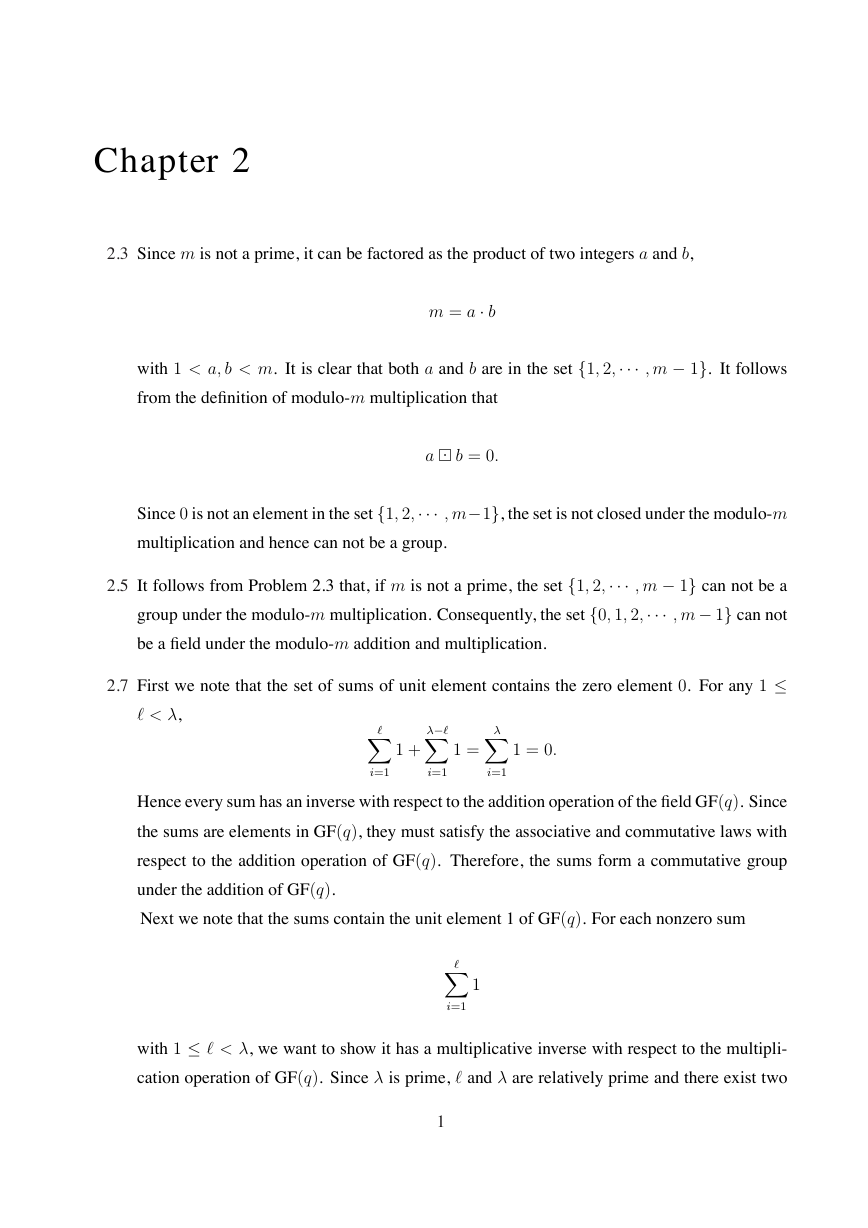
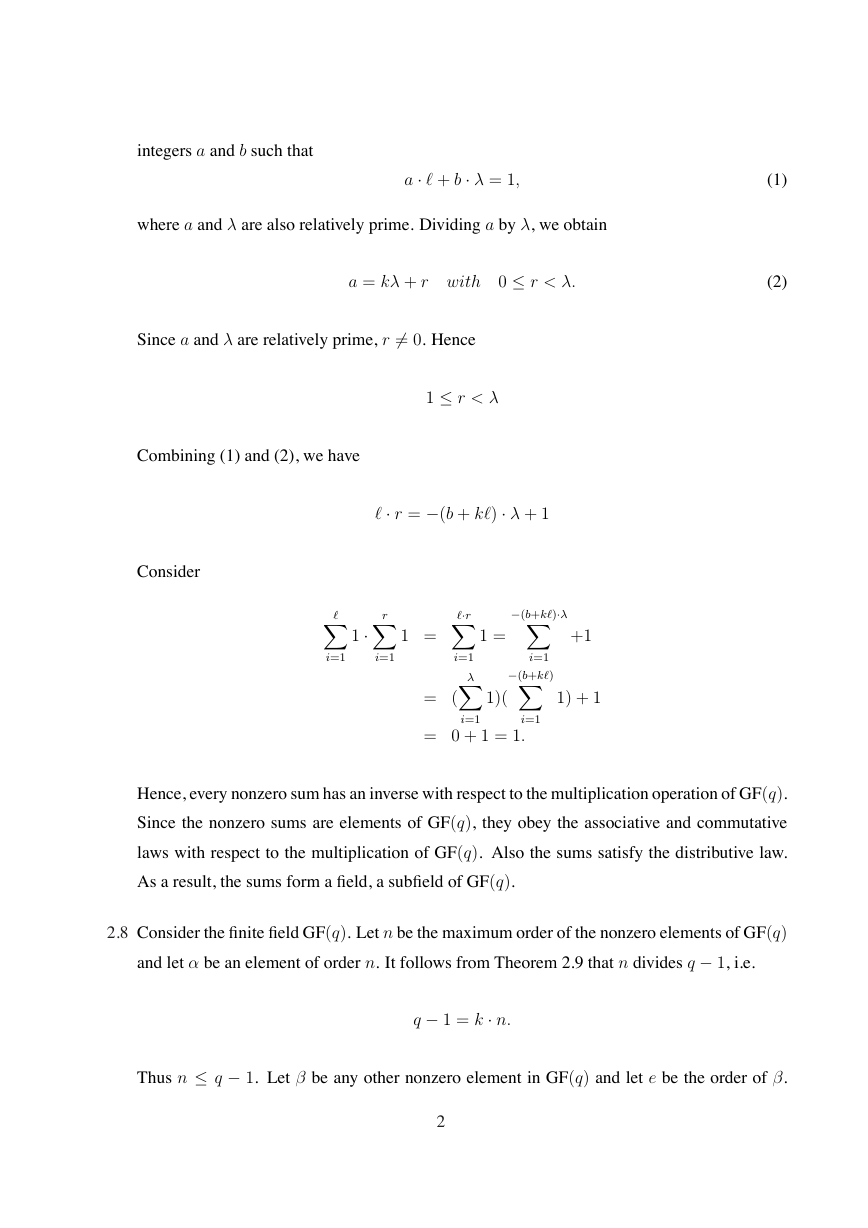
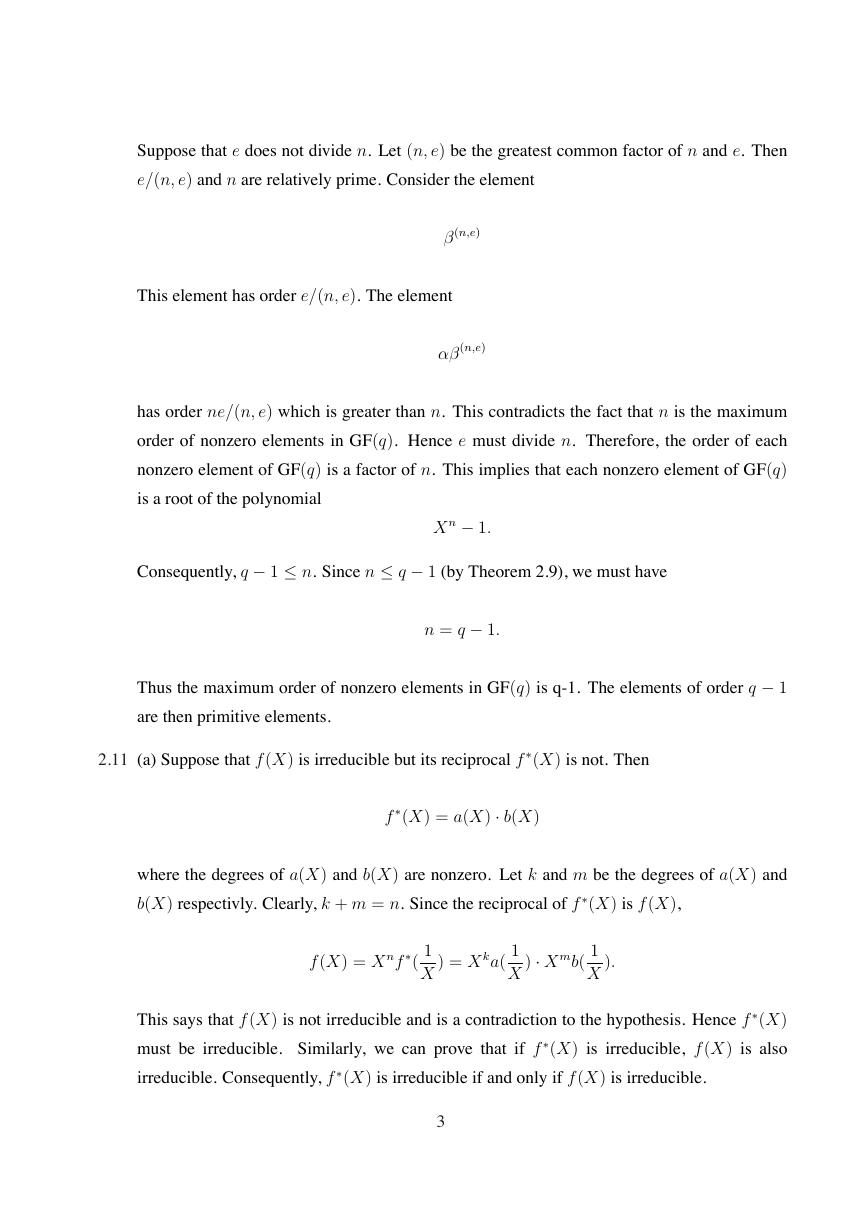
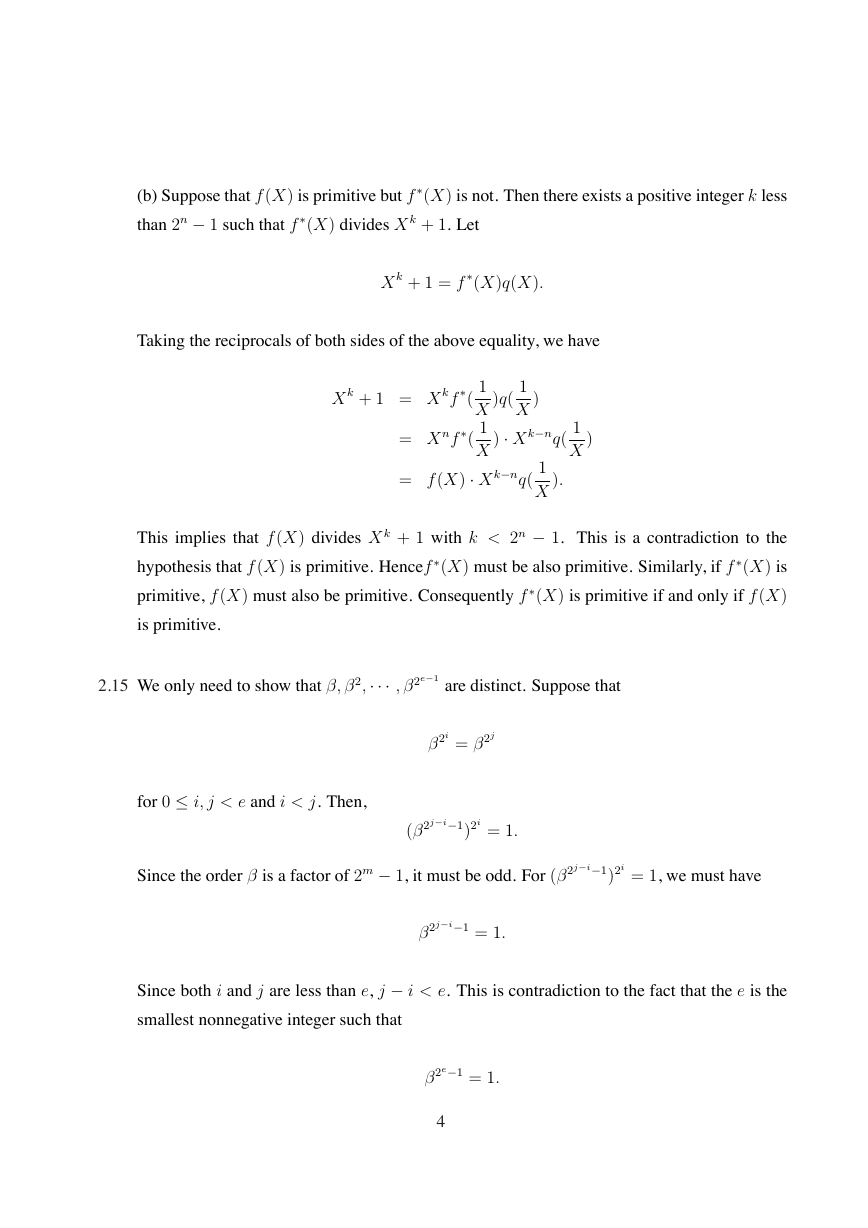
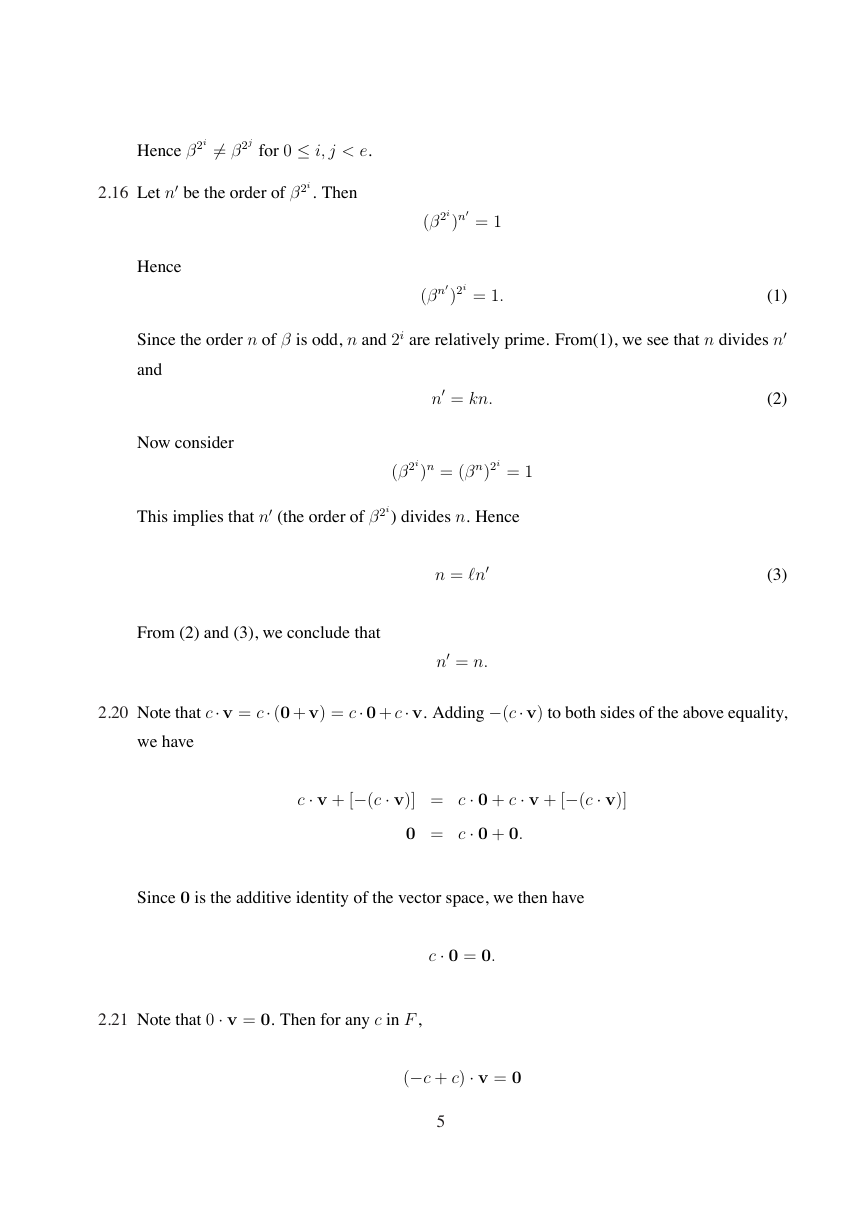
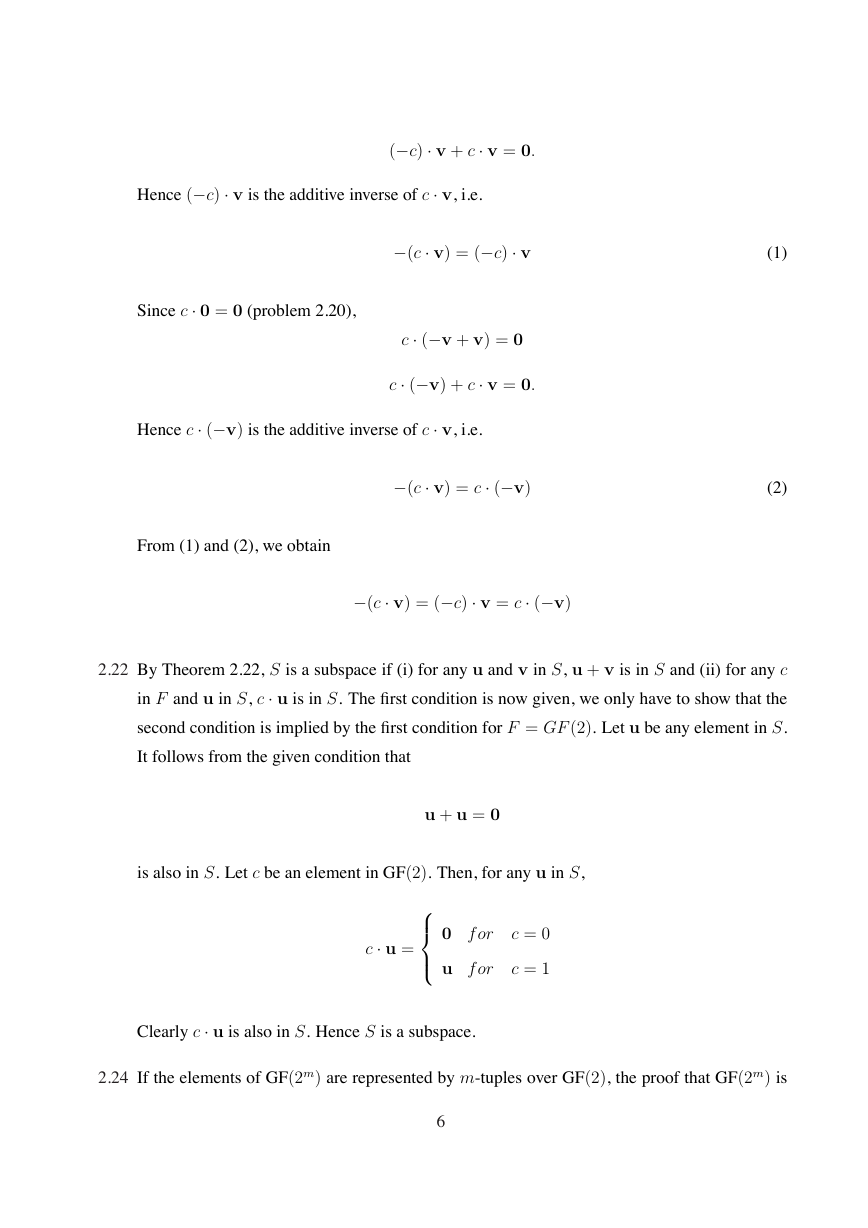
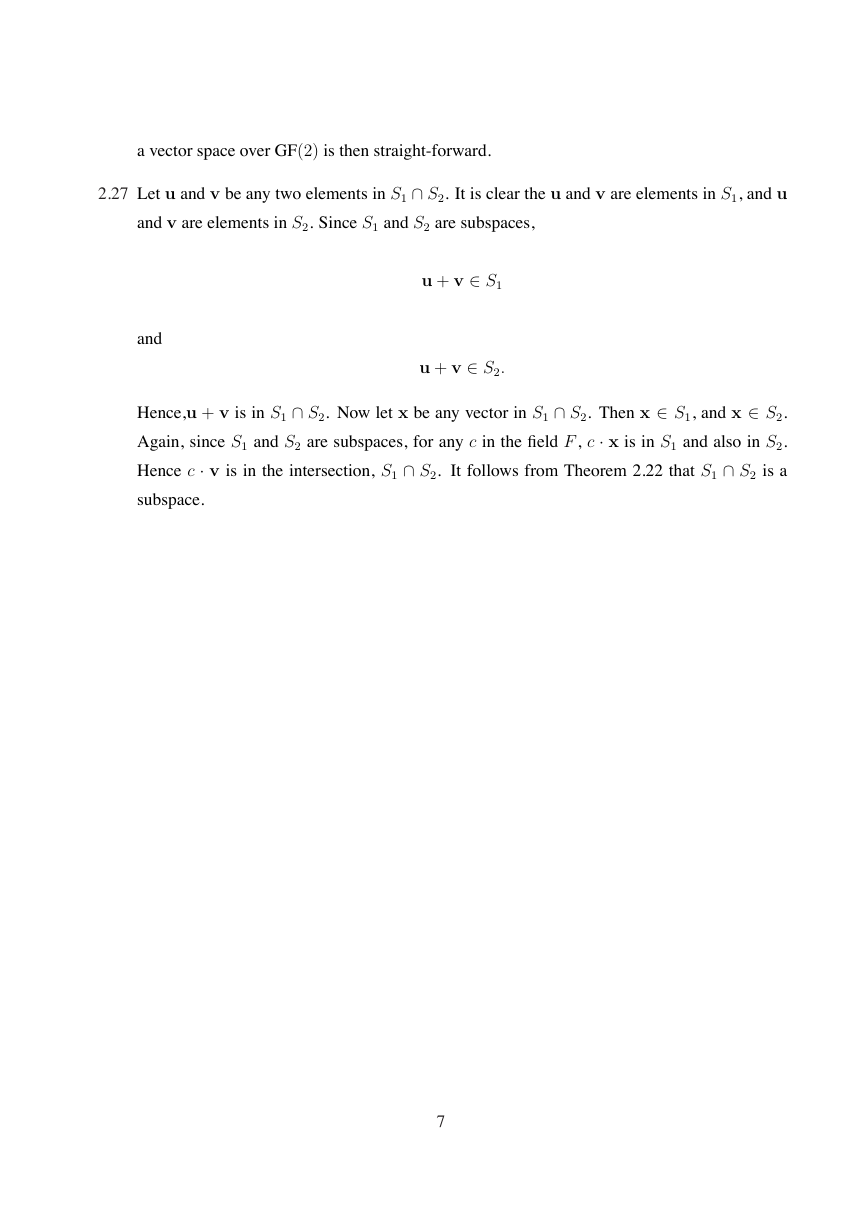









 2023年江西萍乡中考道德与法治真题及答案.doc
2023年江西萍乡中考道德与法治真题及答案.doc 2012年重庆南川中考生物真题及答案.doc
2012年重庆南川中考生物真题及答案.doc 2013年江西师范大学地理学综合及文艺理论基础考研真题.doc
2013年江西师范大学地理学综合及文艺理论基础考研真题.doc 2020年四川甘孜小升初语文真题及答案I卷.doc
2020年四川甘孜小升初语文真题及答案I卷.doc 2020年注册岩土工程师专业基础考试真题及答案.doc
2020年注册岩土工程师专业基础考试真题及答案.doc 2023-2024学年福建省厦门市九年级上学期数学月考试题及答案.doc
2023-2024学年福建省厦门市九年级上学期数学月考试题及答案.doc 2021-2022学年辽宁省沈阳市大东区九年级上学期语文期末试题及答案.doc
2021-2022学年辽宁省沈阳市大东区九年级上学期语文期末试题及答案.doc 2022-2023学年北京东城区初三第一学期物理期末试卷及答案.doc
2022-2023学年北京东城区初三第一学期物理期末试卷及答案.doc 2018上半年江西教师资格初中地理学科知识与教学能力真题及答案.doc
2018上半年江西教师资格初中地理学科知识与教学能力真题及答案.doc 2012年河北国家公务员申论考试真题及答案-省级.doc
2012年河北国家公务员申论考试真题及答案-省级.doc 2020-2021学年江苏省扬州市江都区邵樊片九年级上学期数学第一次质量检测试题及答案.doc
2020-2021学年江苏省扬州市江都区邵樊片九年级上学期数学第一次质量检测试题及答案.doc 2022下半年黑龙江教师资格证中学综合素质真题及答案.doc
2022下半年黑龙江教师资格证中学综合素质真题及答案.doc